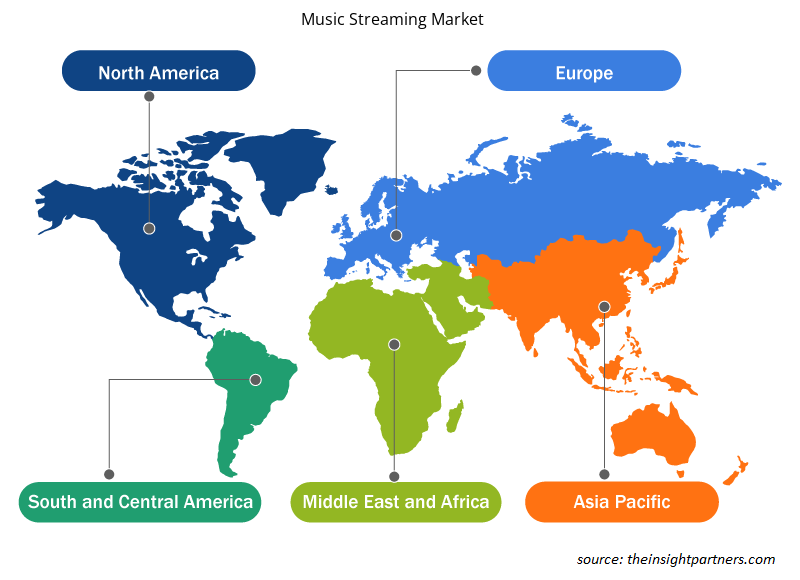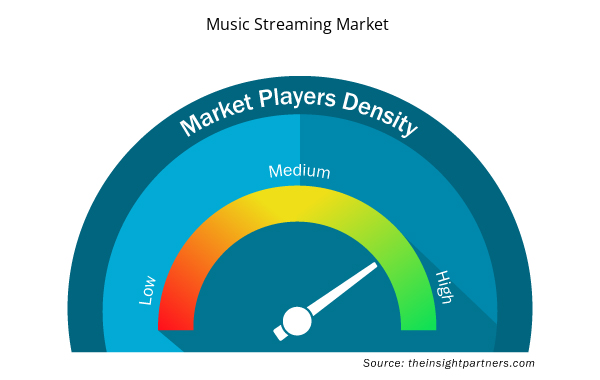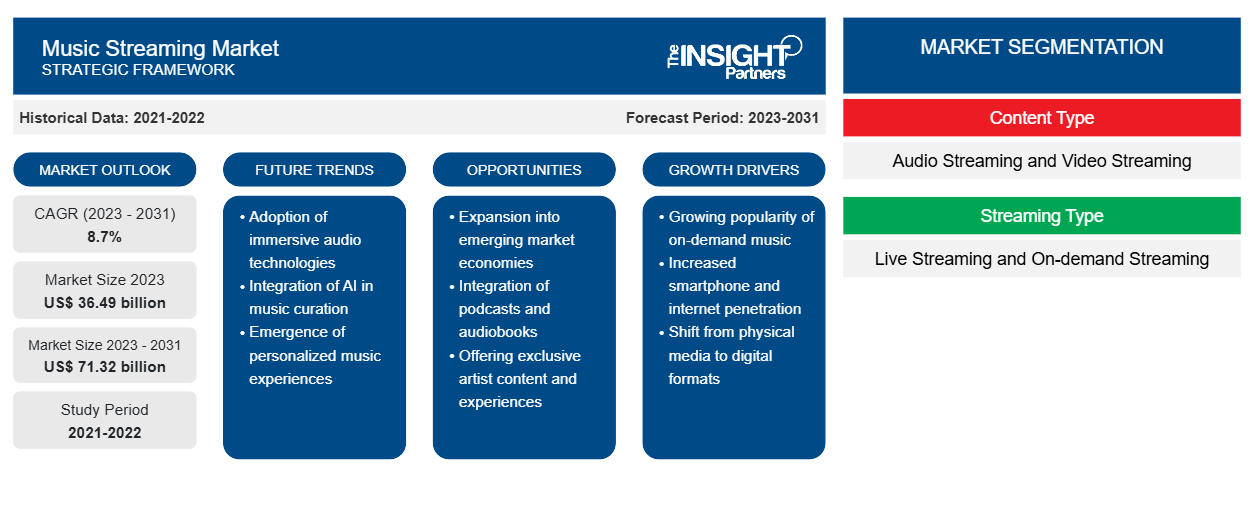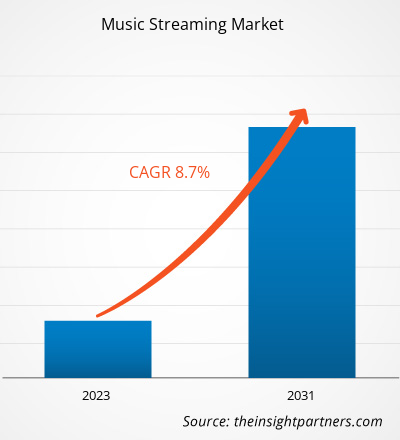Der Markt für Musikstreaming soll von 36,49 Milliarden US-Dollar im Jahr 2023 auf 71,32 Milliarden US-Dollar im Jahr 2031 anwachsen. Von 2023 bis 2031 wird für den Markt eine durchschnittliche jährliche Wachstumsrate (CAGR) von 8,7 % erwartet.
Die zunehmende Nutzung der 5G-Konnektivität und die wachsende Nachfrage nach Live-Streaming von Musikshows werden voraussichtlich ein wichtiger Trend auf dem Musik-Streaming-Markt bleiben.
Musik-Streaming-Marktanalyse
Der Markt für Musikstreaming wächst rasant aufgrund der steigenden Nachfrage nach Geräten mit Multi-Device-Kompatibilität, der zunehmenden Verbreitung digitaler Plattformen und der zunehmenden Nutzung intelligenter Geräte mit nahtloser Zugänglichkeit. Der Markt wächst stetig, angetrieben durch den zunehmenden Fokus der Marktteilnehmer, das Kundenerlebnis durch die Bereitstellung werbefreier Abonnements zu verbessern. Darüber hinaus bieten die zunehmende Verbreitung von Online-3D-Musikstreaming und die Integration fortschrittlicher Technologien wie KI und ML zur Verbesserung des Streaming-Erlebnisses von Musik durch verbesserte Suchempfehlungen lukrative Möglichkeiten für Marktwachstum.
Überblick über den Musik-Streaming-Markt
Musikstreaming ist eine Methode, um Audioinhalte, hauptsächlich Musik, auf die Geräte der Hörer zu übertragen, ohne dass Dateien aus dem Internet heruntergeladen werden müssen. Musikstreaming macht das Herunterladen und Speichern von Musikdateien überflüssig, indem es den Benutzern über Streamingdienste Zugriff auf eine umfangreiche Liste von Songs bietet. Diese Streamingdienste ermöglichen es Benutzern, Musik auf einer Vielzahl von Geräten wie Smartphones, intelligenten Lautsprechern, Computern, Tablets und anderen zu hören, indem sie die Audioinhalte direkt über eine Internetverbindung streamen.
Passen Sie diesen Bericht Ihren Anforderungen an
Sie erhalten kostenlose Anpassungen an jedem Bericht, einschließlich Teilen dieses Berichts oder einer Analyse auf Länderebene, eines Excel-Datenpakets sowie tolle Angebote und Rabatte für Start-ups und Universitäten.
- Holen Sie sich die wichtigsten Markttrends aus diesem Bericht.Dieses KOSTENLOSE Beispiel umfasst eine Datenanalyse von Markttrends bis hin zu Schätzungen und Prognosen.
Treiber und Chancen auf dem Musikstreamingmarkt
Die wachsende Nachfrage nach Geräten mit Multi-Device-Kompatibilität treibt den Markt an
Die zunehmende Digitalisierung, der technologische Fortschritt und die zunehmende Nutzung moderner Technologien zur Bereitstellung von Musik im digitalen Format ermutigen Hersteller, geräteübergreifend kompatible Geräte zu entwickeln, um die Bedürfnisse ihrer Kunden zu erfüllen. Die steigende Nachfrage nach verschiedenen Arten von geräteübergreifend kompatiblen Geräten wie Smartphones, intelligenten Lautsprechern , HD-Fernsehern, Smartwatches und verschiedenen Geräten mit Sprachassistenten, darunter Amazon Alexa, Apple Siri, Microsoft Cortana und Samsung Bixby, treibt den Markt an. Dies erhöht den Fokus der Marktteilnehmer darauf, geräteübergreifend kompatible Geräte anzubieten, um den Benutzern ein besseres Hörerlebnis zu bieten. Benutzer auf der ganzen Welt nehmen geräteübergreifend kompatible Geräte in hohem Maße als effektive Unterhaltungsoption an. Darüber hinaus beflügelt die wachsende Zahl von Musikhörern und App-Abonnenten den Markt.
Zunehmende Nutzung von Online-3D-Musikstreaming – eine Chance auf dem Musikstreaming-Markt
Die Einführung digitaler und Cloud-Systeme steigert die Nutzung von On-Demand-Streaming und Musik-Streaming-Plattformen. Diese Entwicklungen ermöglichen es den Erstellern von Musikinhalten, ihren Abonnenten Inhalte über ein Abonnementmodell anzubieten, was einen erheblichen Einfluss auf die Entwicklung von 3D-Audio-Songlisten und Musik-Streaming-Plattformen hat. Die Anbieter von Musik-Streaming-Diensten bieten 3D-Audiomusik an, um durch die Erhöhung der Abonnementzahlen einen riesigen Kundenstamm anzuziehen. Die wachsende Nachfrage nach Musik-Streaming-Apps schafft ebenfalls Chancen auf dem Markt. Indien beispielsweise wird zu einem Zentrum für Anbieter von Musikinhalten, und die einfache Verfügbarkeit von Musik-Streaming-Apps wie Amazon Prime, Gaana.com und Saawan.com ermöglicht es den Anbietern von Musikinhalten, den Zuhörern eine Liste mit 3D-Songs anzubieten.
Segmentierungsanalyse des Musikstreaming-Marktberichts
Wichtige Segmente, die zur Ableitung der Musikstreaming-Marktanalyse beigetragen haben, sind Inhaltstyp, Streaming-Typ und Endbenutzer.
- Basierend auf dem Inhaltstyp ist der Musikstreamingmarkt in Audiostreaming und Videostreaming unterteilt. Das Segment Audiostreaming hatte im Jahr 2023 einen größeren Marktanteil.
- In Bezug auf die Streaming-Art ist der Musik-Streaming-Markt in Live-Streaming und On-Demand-Streaming unterteilt. Das On-Demand-Streaming-Segment hatte im Jahr 2023 einen größeren Marktanteil.
- Auf der Grundlage des Endnutzers wird der Markt in gewerbliche und private Segmente unterteilt. Das Segment der Privatkunden hielt im Jahr 2023 den größten Marktanteil.
Marktanteilsanalyse für Musikstreaming nach geografischer Lage
Der geografische Umfang des Musikstreaming-Marktberichts ist hauptsächlich in fünf Regionen unterteilt: Nordamerika, Asien-Pazifik, Europa, Naher Osten und Afrika sowie Südamerika/Süd- und Mittelamerika.
In Bezug auf den Umsatz hatte Nordamerika den größten Marktanteil im Musikstreaming. Wichtige Akteure wie Amazon, Inc., Apple Inc., Pandora Media, Inc. und Spotify Tidal sind hier vertreten. Diese Akteure sind ständig damit beschäftigt, ihren Hörern hochwertige Audio- und Videostreaming- Lösungen anzubieten. Die zunehmende Nutzung von Social-Media-Plattformen und die Entwicklung von Apps zur Künstleranalyse schaffen Chancen auf dem Markt.
Neuigkeiten und aktuelle Entwicklungen zum Musik-Streaming-Markt
Der Markt für Musikstreaming wird durch die Erhebung qualitativer und quantitativer Daten nach Primär- und Sekundärforschung bewertet, die wichtige Unternehmensveröffentlichungen, Verbandsdaten und Datenbanken umfasst. Im Folgenden finden Sie eine Liste der Entwicklungen auf dem Markt für Musikstreaming und Strategien:
- Im Februar 2024 zahlte Spotify 9,0 Milliarden US-Dollar an die Musikindustrie. Diese Auszahlung beinhaltet die an Rechteinhaber und Künstler ausgeschütteten Einnahmen. (Quelle: Spotify, Pressemitteilung, 2024)
- Im November 2022 erweiterte Amazon Music sein Angebot für Prime-Mitglieder und stellte ihnen einen vollständigen Katalog mit 100 Millionen Songs und den besten Podcasts ohne Werbekosten zur Verfügung. (Quelle: Amazon, Inc., Pressemitteilung, 2022)
Regionale Einblicke in den Musikstreamingmarkt
Die regionalen Trends und Faktoren, die den Musikstreaming-Markt im Prognosezeitraum beeinflussen, wurden von den Analysten von Insight Partners ausführlich erläutert. In diesem Abschnitt werden auch die Marktsegmente und die Geografie des Musikstreaming-Marktes in Nordamerika, Europa, im asiatisch-pazifischen Raum, im Nahen Osten und Afrika sowie in Süd- und Mittelamerika erörtert.

- Holen Sie sich regionale Daten zum Musik-Streaming-Markt
Umfang des Marktberichts zum Musikstreaming
| Berichtsattribut | Details |
|---|---|
| Marktgröße im Jahr 2023 | 36,49 Milliarden US-Dollar |
| Marktgröße bis 2031 | 71,32 Milliarden US-Dollar |
| Globale CAGR (2023 - 2031) | 8,7 % |
| Historische Daten | 2021-2022 |
| Prognosezeitraum | 2023–2031 |
| Abgedeckte Segmente | Nach Inhaltstyp
|
| Abgedeckte Regionen und Länder | Nordamerika
|
| Marktführer und wichtige Unternehmensprofile |
|
Dichte der Akteure auf dem Musik-Streaming-Markt: Die Auswirkungen auf die Geschäftsdynamik verstehen
Der Markt für Musikstreaming wächst rasant. Dies wird durch die steigende Nachfrage der Endnutzer aufgrund von Faktoren wie sich entwickelnden Verbraucherpräferenzen, technologischen Fortschritten und einem größeren Bewusstsein für die Vorteile des Produkts vorangetrieben. Mit der steigenden Nachfrage erweitern Unternehmen ihr Angebot, entwickeln Innovationen, um die Bedürfnisse der Verbraucher zu erfüllen, und nutzen neue Trends, was das Marktwachstum weiter ankurbelt.
Die Marktteilnehmerdichte bezieht sich auf die Verteilung der Firmen oder Unternehmen, die in einem bestimmten Markt oder einer bestimmten Branche tätig sind. Sie gibt an, wie viele Wettbewerber (Marktteilnehmer) in einem bestimmten Marktraum im Verhältnis zu seiner Größe oder seinem gesamten Marktwert präsent sind.
Die wichtigsten Unternehmen auf dem Musik-Streaming-Markt sind:
- Amazon, Inc.
- Apple Inc.
- Deezer
- Google Inc.
- iheartmedia, Inc.
- Joox
Haftungsausschluss : Die oben aufgeführten Unternehmen sind nicht in einer bestimmten Reihenfolge aufgeführt.

- Überblick über die wichtigsten Akteure auf dem Musikstreamingmarkt
Marktbericht zum Musikstreaming – Umfang und Ergebnisse
Der Bericht „Marktgröße und Prognose für Musikstreaming (2023–2031)“ bietet eine detaillierte Analyse des Marktes, die die folgenden Bereiche abdeckt:
- Marktgröße und Prognose auf globaler, regionaler und Länderebene für alle wichtigen Marktsegmente, die im Rahmen des Projekts abgedeckt sind
- Marktdynamik wie Treiber, Beschränkungen und wichtige Chancen
- Wichtige Zukunftstrends
- Detaillierte PEST/Porters Five Forces- und SWOT-Analyse
- Globale und regionale Marktanalyse mit wichtigen Markttrends, wichtigen Akteuren, Vorschriften und aktuellen Marktentwicklungen
- Branchenlandschaft und Wettbewerbsanalyse, einschließlich Marktkonzentration, Heatmap-Analyse, prominenten Akteuren und aktuellen Entwicklungen
- Detaillierte Firmenprofile
- Historische Analyse (2 Jahre), Basisjahr, Prognose (7 Jahre) mit CAGR
- PEST- und SWOT-Analyse
- Marktgröße Wert/Volumen – Global, Regional, Land
- Branche und Wettbewerbsumfeld
- Excel-Datensatz



Report Coverage
Revenue forecast, Company Analysis, Industry landscape, Growth factors, and Trends

Segment Covered
This text is related
to segments covered.

Regional Scope
North America, Europe, Asia Pacific, Middle East & Africa, South & Central America

Country Scope
This text is related
to country scope.
Häufig gestellte Fragen
The growing demand for multi-device compatibility devices, increasing adoption of digital platforms, and growing utilization of smart devices with seamless accessibility are the major factors that propel the global music streaming market.
The global music streaming market was estimated to be US$ 36.49 billion in 2023 and is expected to grow at a CAGR of 8.7% during the forecast period 2023 - 2031.
The rising adoption of 5G connectivity and the growing demand for live streaming of music shows are anticipated to play a significant role in the global music streaming market in the coming years.
The key players holding majority shares in the global music streaming market are Amazon, Inc., Apple Inc., Deezer, Google Inc., and iheartmedia, Inc.
The global music streaming market is expected to reach US$ 71.32 billion by 2031.
The incremental growth expected to be recorded for the global music streaming market during the forecast period is US$ 34.83 billion.
Trends and growth analysis reports related to Technology, Media and Telecommunications : READ MORE..
- Amazon, Inc.
- Apple Inc.
- Deezer
- Google Inc.
- iheartmedia, Inc.
- Joox
- Pandora Media, Inc.
- SoundCloud
- Spotify
- Tidal
The Insight Partners performs research in 4 major stages: Data Collection & Secondary Research, Primary Research, Data Analysis and Data Triangulation & Final Review.
- Data Collection and Secondary Research:
As a market research and consulting firm operating from a decade, we have published and advised several client across the globe. First step for any study will start with an assessment of currently available data and insights from existing reports. Further, historical and current market information is collected from Investor Presentations, Annual Reports, SEC Filings, etc., and other information related to company’s performance and market positioning are gathered from Paid Databases (Factiva, Hoovers, and Reuters) and various other publications available in public domain.
Several associations trade associates, technical forums, institutes, societies and organization are accessed to gain technical as well as market related insights through their publications such as research papers, blogs and press releases related to the studies are referred to get cues about the market. Further, white papers, journals, magazines, and other news articles published in last 3 years are scrutinized and analyzed to understand the current market trends.
- Primary Research:
The primarily interview analysis comprise of data obtained from industry participants interview and answers to survey questions gathered by in-house primary team.
For primary research, interviews are conducted with industry experts/CEOs/Marketing Managers/VPs/Subject Matter Experts from both demand and supply side to get a 360-degree view of the market. The primary team conducts several interviews based on the complexity of the markets to understand the various market trends and dynamics which makes research more credible and precise.
A typical research interview fulfils the following functions:
- Provides first-hand information on the market size, market trends, growth trends, competitive landscape, and outlook
- Validates and strengthens in-house secondary research findings
- Develops the analysis team’s expertise and market understanding
Primary research involves email interactions and telephone interviews for each market, category, segment, and sub-segment across geographies. The participants who typically take part in such a process include, but are not limited to:
- Industry participants: VPs, business development managers, market intelligence managers and national sales managers
- Outside experts: Valuation experts, research analysts and key opinion leaders specializing in the electronics and semiconductor industry.
Below is the breakup of our primary respondents by company, designation, and region:

Once we receive the confirmation from primary research sources or primary respondents, we finalize the base year market estimation and forecast the data as per the macroeconomic and microeconomic factors assessed during data collection.
- Data Analysis:
Once data is validated through both secondary as well as primary respondents, we finalize the market estimations by hypothesis formulation and factor analysis at regional and country level.
- Macro-Economic Factor Analysis:
We analyse macroeconomic indicators such the gross domestic product (GDP), increase in the demand for goods and services across industries, technological advancement, regional economic growth, governmental policies, the influence of COVID-19, PEST analysis, and other aspects. This analysis aids in setting benchmarks for various nations/regions and approximating market splits. Additionally, the general trend of the aforementioned components aid in determining the market's development possibilities.
- Country Level Data:
Various factors that are especially aligned to the country are taken into account to determine the market size for a certain area and country, including the presence of vendors, such as headquarters and offices, the country's GDP, demand patterns, and industry growth. To comprehend the market dynamics for the nation, a number of growth variables, inhibitors, application areas, and current market trends are researched. The aforementioned elements aid in determining the country's overall market's growth potential.
- Company Profile:
The “Table of Contents” is formulated by listing and analyzing more than 25 - 30 companies operating in the market ecosystem across geographies. However, we profile only 10 companies as a standard practice in our syndicate reports. These 10 companies comprise leading, emerging, and regional players. Nonetheless, our analysis is not restricted to the 10 listed companies, we also analyze other companies present in the market to develop a holistic view and understand the prevailing trends. The “Company Profiles” section in the report covers key facts, business description, products & services, financial information, SWOT analysis, and key developments. The financial information presented is extracted from the annual reports and official documents of the publicly listed companies. Upon collecting the information for the sections of respective companies, we verify them via various primary sources and then compile the data in respective company profiles. The company level information helps us in deriving the base number as well as in forecasting the market size.
- Developing Base Number:
Aggregation of sales statistics (2020-2022) and macro-economic factor, and other secondary and primary research insights are utilized to arrive at base number and related market shares for 2022. The data gaps are identified in this step and relevant market data is analyzed, collected from paid primary interviews or databases. On finalizing the base year market size, forecasts are developed on the basis of macro-economic, industry and market growth factors and company level analysis.
- Data Triangulation and Final Review:
The market findings and base year market size calculations are validated from supply as well as demand side. Demand side validations are based on macro-economic factor analysis and benchmarks for respective regions and countries. In case of supply side validations, revenues of major companies are estimated (in case not available) based on industry benchmark, approximate number of employees, product portfolio, and primary interviews revenues are gathered. Further revenue from target product/service segment is assessed to avoid overshooting of market statistics. In case of heavy deviations between supply and demand side values, all thes steps are repeated to achieve synchronization.
We follow an iterative model, wherein we share our research findings with Subject Matter Experts (SME’s) and Key Opinion Leaders (KOLs) until consensus view of the market is not formulated – this model negates any drastic deviation in the opinions of experts. Only validated and universally acceptable research findings are quoted in our reports.
We have important check points that we use to validate our research findings – which we call – data triangulation, where we validate the information, we generate from secondary sources with primary interviews and then we re-validate with our internal data bases and Subject matter experts. This comprehensive model enables us to deliver high quality, reliable data in shortest possible time.


 Holen Sie sich ein kostenloses Muster für diesen Bericht
Holen Sie sich ein kostenloses Muster für diesen Bericht